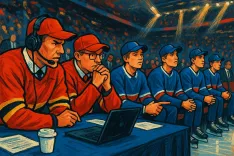J.T. Millers Almost Return to New York: Analyzing the Canucks-Rangers Negotiations

J.T. Miller, drafted as a first-round pick by the New York Rangers in the 2011 NHL Draft, made his debut with the team less than two years later and spent parts of six seasons in New York. He transitioned to the Tampa Bay Lightning at the 2018 trade deadline and subsequently joined the Vancouver Canucks after the 2018-19 season. Recently, there were negotiations that nearly facilitated Miller's return to Madison Square Garden in a deal that would have exchanged the 31-year-old center—who recorded an impressive 103 points last season—for the young center Filip Chytil, defenseman Ryan Lindgren, and possibly a first-round pick. However, complications related to the protection structure of the pick ultimately hindered the potential deal. Reports also suggest that a strained relationship between Miller and teammate Elias Pettersson has led the Canucks to explore market options for both players. Although Miller holds a no-movement clause and is under contract through 2030, some teams have received permission to engage with him regarding a trade. This proposed transaction with New York prompted discussions among analysts concerning the implications of such a move, evaluating the potential winners and losers of the trade.
The dynamics between Miller and Pettersson have become increasingly complex. Pettersson, drafted fifth overall in 2017, had a stellar 66-point rookie season with the Canucks before Miller joined the team the following summer. Together, they have contributed to the Canucks' achievement of a Pacific Division title, two playoff appearances, and three series victories over the past five seasons. However, recent developments indicate a deterioration in their partnership. NHL insider Elliotte Friedman has reported that Pettersson has expressed a desire to remain in British Columbia, hinting that the team's management may favor keeping him over trading Miller. Despite signing a lucrative eight-year, $92.8 million contract in March, Pettersson has faced challenges during the 2024-25 season, projected to tally only 19 goals and 57 points, significantly below his performance in previous seasons where he averaged over a point per game.
The trade discussions not only highlight headline-worthy maneuvers for fans, but they also shed light on the precarious position of the Canucks' management. General Manager Patrik Allvin and hockey operations executive Jim Rutherford find themselves with limited leverage regarding Miller, especially considering the proposed return from the Rangers—Chytil, Lindgren, and a potential pick—which would fall short of the typical compensation expected for a player coming off a 103-point season. While Chytil has demonstrated potential over several seasons, he has primarily functioned as a third-line player, recording a career-high of only 22 goals. Lindgren, dwelling on the Rangers' top defensive pair alongside former Norris Trophy winner Adam Fox, has seen a decline in his performance metrics and is approaching unrestricted free agency in the coming summer. Additionally, any draft pick acquired in a deal for Miller is likely to be a mid-round selection, especially in a 2025 class that possesses elite talent at the top, but lacks depth in comparison to recent drafts. The intense pressure of competing in New York, coupled with the continued scrutiny from a passionate fanbase, places additional strain on the Rangers as they attempt to navigate their roster strategy effectively.









